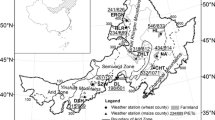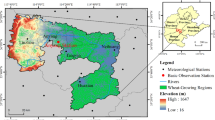Abstract
The Palmer drought severity index (PDSI), standardized precipitation index (SPI), and standardized precipitation evapotranspiration index (SPEI) are used worldwide for drought assessment and monitoring. However, substantial differences exist in the performance for agricultural drought among these indices and among regions. Here, we performed statistical assessments to compare the strengths of different drought indices for agricultural drought in the North China Plain. Small differences were detected in the comparative performances of SPI and SPEI that were smaller at the long-term scale than those at the short-term scale. The correlation between SPI/SPEI and PDSI considerably increased from 1- to 12-month lags, and a slight decreasing trend was exhibited during 12- and 24-month lags, indicating a 12-month scale in the PDSI, whereas the SPI was strongly correlated with the SPEI at 1- to 24-month lags. Interestingly, the correlation between the trend of temperature and the mean absolute error and its correlation coefficient both suggested stronger relationships between SPI and the SPEI in areas of rapid climate warming. In addition, the yield–drought correlations tended to be higher for the SPI and SPEI than that for the PDSI at the station scale, whereas small differences were detected between the SPI and SPEI in the performance on agricultural systems. However, large differences in the influence of drought conditions on the yields of winter wheat and summer maize were evident among various indices during the crop-growing season. Our findings suggested that multi-indices in drought monitoring are needed in order to acquire robust conclusions.
Similar content being viewed by others
References
AghaKouchak A, Farahmand A, Melton F S, et al. 2015. Remote sensing of drought: progress, challenges and opportunities. Reviews of Geophysics, 53(2): 452–480.
Alley W M. 1984. The palmer drought severity index: limitations and assumptions. Journal of Climate and Applied Meteorology, 23(7): 1100–1109.
Dai A G. 2011. Drought under global warming: a review. Wiley Interdisciplinary Reviews: Climate Change, 2(1): 45–65.
Dai A G. 2013. Increasing drought under global warming in observations and models. Nature Climate Change, 3(1): 52–58.
Drobyshev I, Niklasson M, Linderholm H W. 2012. Forest fire activity in Sweden: climatic controls and geographical patterns in 20th century. Agricultural and Forest Meteorology, 154–155: 174–186.
Du L T, Tian Q J, Yu T, et al. 2013. A comprehensive drought monitoring method integrating MODIS and TRMM data. International Journal of Applied Earth Observation and Geoinformation, 23: 245–253.
Hao C, Zhang J H, Yao F M. 2015. Combination of multi-sensor remote sensing data for drought monitoring over Southwest China. International Journal of Applied Earth Observation and Geoinformation, 35: 270–283.
Hao Z C, Singh V P. 2015. Drought characterization from a multivariate perspective: a review. Journal of Hydrology, 527: 668–678.
Heim R R Jr. 2002. A review of twentieth-century drought indices used in the United States. Bulletin of the American Meteorological Society, 83(8): 1149–1166.
Hu S, Mo X G, Lin Z H, et al. 2010. Emergy assessment of a wheat-maize rotation system with different water assignments in the North China Plain. Environmental Management, 46(4): 643–657.
Hu Y N. 2013. Drought risk assessment of winter wheat and summer maize rotation planting region in North China Plain. PhD Dissertation. Beijing: Chinese Academy of Agricultural Sciences. (in Chinese)
Jiang R G, Xie J C, He H L, et al. 2015. Use of four drought indices for evaluating drought characteristics under climate change in Shaanxi, China: 1951–2012. Natural Hazards, 75(3): 2885–2903.
Kempes C P, Myers O B, Breshears D D, et al. 2008. Comparing response of Pinus edulis tree-ring growth to five alternate moisture indices using historic meteorological data. Journal of Arid Environments, 72(4): 350–357.
Mavromatis T. 2007. Drought index evaluation for assessing future wheat production in Greece. International Journal of Climatology, 27(7): 911–924.
Mavromatis T. 2010. Use of drought indices in climate change impact assessment studies: an application to Greece. International Journal of Climatology, 30(9): 1336–1348, doi: 10.1002/joc.1976.
McKee T B, Doesken N J, Kleist J. 1993. The relationship of drought frequency and duration to time scales. In: Proceedings of the 8th Conference on Applied Climatology. Anaheim, CA: American Meteorological Society.
Mishra A K, Singh V P. 2010. A review of drought concepts. Journal of Hydrology, 391(1–2): 202–216.
Mu Q Z, Zhao M S, Kimball J S, et al. 2013. A remotely sensed global terrestrial drought severity index. Bulletin of the American Meteorological Society, 94(1): 83–98.
Nichol J E, Abbas S. 2015. Integration of remote sensing datasets for local scale assessment and prediction of drought. Science of the Total Environment, 505: 503–507.
Palmer W C. 1965. Meteorological Drought. Washington: US Department of Commerce, Weather Bureau.
Potop V. 2011. Evolution of drought severity and its impact on corn in the Republic of Moldova. Theoretical and Applied Climatology, 105(3–4): 469–483.
Potopová V, Štěpánek P, Možný M, et al. 2015. Performance of the standardised precipitation evapotranspiration index at various lags for agricultural drought risk assessment in the Czech Republic. Agricultural and Forest Meteorology, 202: 26–38.
Quiring S M, Ganesh S. 2010. Evaluating the utility of the Vegetation Condition Index (VCI) for monitoring meteorological drought in Texas. Agricultural and Forest Meteorology, 150(3): 330–339.
Vicente-Serrano S M, Beguería S, López-Moreno J I. 2010. A multiscalar drought index sensitive to global warming: the standardized precipitation evapotranspiration index. Journal of Climate, 23(7): 1696–1718.
Vicente-Serrano S M, Begueria S, Lorenzo-Lacruz J, et al. 2012. Performance of drought indices for ecological, agricultural, and hydrological applications. Earth Interactions, 16(10): 1–27.
Wegren S K. 2011. Food security and Russia's 2010 drought. Eurasian Geography and Economics, 52(1): 140–156.
Wells N, Goddard S, Hayes M J. 2004. A self-calibrating palmer drought severity index. Journal of Climate, 17(12): 2335–2351.
Wilhite D A, Glantz M H. 1985. Understanding: the drought phenomenon: the role of definitions. Water International, 10(3): 111–120.
Yang Q, Li M X, Zheng Z Y, et al. 2017. Regional applicability of seven meteorological drought indices in China. Science China Earth Sciences, 60(4): 745–760.
Zhai J Q, Su B D, Krysanova V, et al. 2010. Spatial variation and trend in PDSI and SPI indices and their relation to streamflow in 10 large regions of China. Journal of Climate, 23(3): 649–663.
Acknowledgements
This work was supported by the Fundamental Research Funds for the Central Universities (GK201703049) and the Major Project of High Resolution Earth Observation System, China.
Author information
Authors and Affiliations
Corresponding author
Rights and permissions
About this article
Cite this article
Liu, X., Zhu, X., Pan, Y. et al. Performance of different drought indices for agriculture drought in the North China Plain. J. Arid Land 10, 507–516 (2018). https://doi.org/10.1007/s40333-018-0005-2
Received:
Revised:
Accepted:
Published:
Issue Date:
DOI: https://doi.org/10.1007/s40333-018-0005-2




